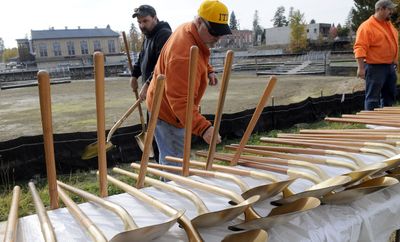Work on byway beginning
2.1-mile-long Sandpoint project was first proposed in 1953

Sandpoint hosted a who’s who of Idaho politics Thursday to celebrate the start of construction for the long-awaited and much-protested Sand Creek Byway, a 2.1-mile, $98 million highway that will provide a direct route around downtown.
“They ought to name this project perseverance,” Gov. Butch Otter said in his keynote address. “This is an economic artery for the state of Idaho, and it had some serious blockage.”
“People are rejoicing at the fact that we are actually going to break some ground,” said U.S. Sen. Mike Crapo. He added, “We all know there are some battle scars over this.”
Meanwhile, opponents of the project, who say it will alter the picturesque waterfront of what has become a destination resort town, were pinning hopes on a lawsuit filed against the U.S. Army Corps of Engineers regarding the permit to dredge and fill parts of Sand Creek.
“Our main problem with it is destruction of the waterfront,” said Liz Sedler, executive director of the North Idaho Community Action Network, a group whose Web site states: “It’s Not Too Late to Stop the Sand Creek Bypass.”
“It’s going to change Sandpoint’s waterfront forever,” she said. “It’s going to be highway walls.”
Decades of scrutiny
First proposed in 1953, the Sand Creek Byway has been subjected to intense scrutiny, accompanied by strong opposition and strong support. In 1953, the Sandpoint News-Bulletin reported that contracts were likely to be awarded that fall.
As U.S. Sen. Larry Craig noted at the groundbreaking, the Clean Water Act, Clean Air Act and Endangered Species Act were passed in the intervening years, requiring additional layers of review. The first environmental impact analysis was completed in 1972 and the project’s current analysis in 1999.
Newspaper archives show that the estimated price of the project has nearly quadrupled in recent years. The byway was expected to cost $25 million in 2001, $45 million in 2003 and $70 million last year, even though the route had not changed. Recently added, however, were a southbound exit ramp allowing an additional route into downtown Sandpoint and a two-mile bike and pedestrian path along the eastern edge of Sand Creek.
Over the years, and continuing today, Sandpoint residents are divided.
“I think it’s going to be awesome,” said Dustin Hendricks, a 20-year resident, as he worked the counter at a downtown restaurant. Hendricks spoke of 45-minute to hourlong delays in getting through Sandpoint in the summer and difficulty crossing the street because of truck traffic. Logging trucks and cattle haulers must negotiate traffic lights and three 90-degree turns to get through downtown Sandpoint, which bills itself as a “walking town.”
Bing Van Dyke, a six-year resident, decried the project’s damage to wetlands and destruction of beachfront.
“I think it’s a horrendous waste of taxpayer money,” he said. “There’s a lot of better places they could spend that money.”
Joe Katz, a former downtown business owner, said keeping a small enterprise alive in Sandpoint is already tough because the town’s tourism is seasonal. He wondered if routing traffic around downtown would kill businesses.
“It’s probably a good thing for the truck traffic, but I don’t know if it will help or hurt business,” he said.
Another appeal promised
In 2005, the Community Action Network sued to stop the project, but U.S. District Judge Edward Lodge rejected the lawsuit, prompting an appeal. Construction was due to begin this summer, but the 9th U.S. Circuit Court of Appeals issued an injunction, then turned down the appeal in August. Sedler acknowledged Lodge would probably reject the current lawsuit against the Army Corps of Engineers, but she promised another appeal to the 9th Circuit.
The rejection of the most recent appeal, however, gave the Idaho Transportation Department the green light for construction. Earlier this month, Parsons RCI of Sumner, Wash., an international engineering and construction firm with revenues in the billions of dollars, was awarded the $98 million contract.
The work will include new two-lane and three-lane sections along the east side of Sand Creek, including two interchanges, three steel-girder bridges, a steel arch girder bridge and 17 mechanically stabilized earthen walls.
ITD resident engineer Ken Sorensen said work will begin soon on the southbound structures. Dredging in Sand Creek also will begin soon, he said.
The ITD predicts completion of the project by the summer of 2012.